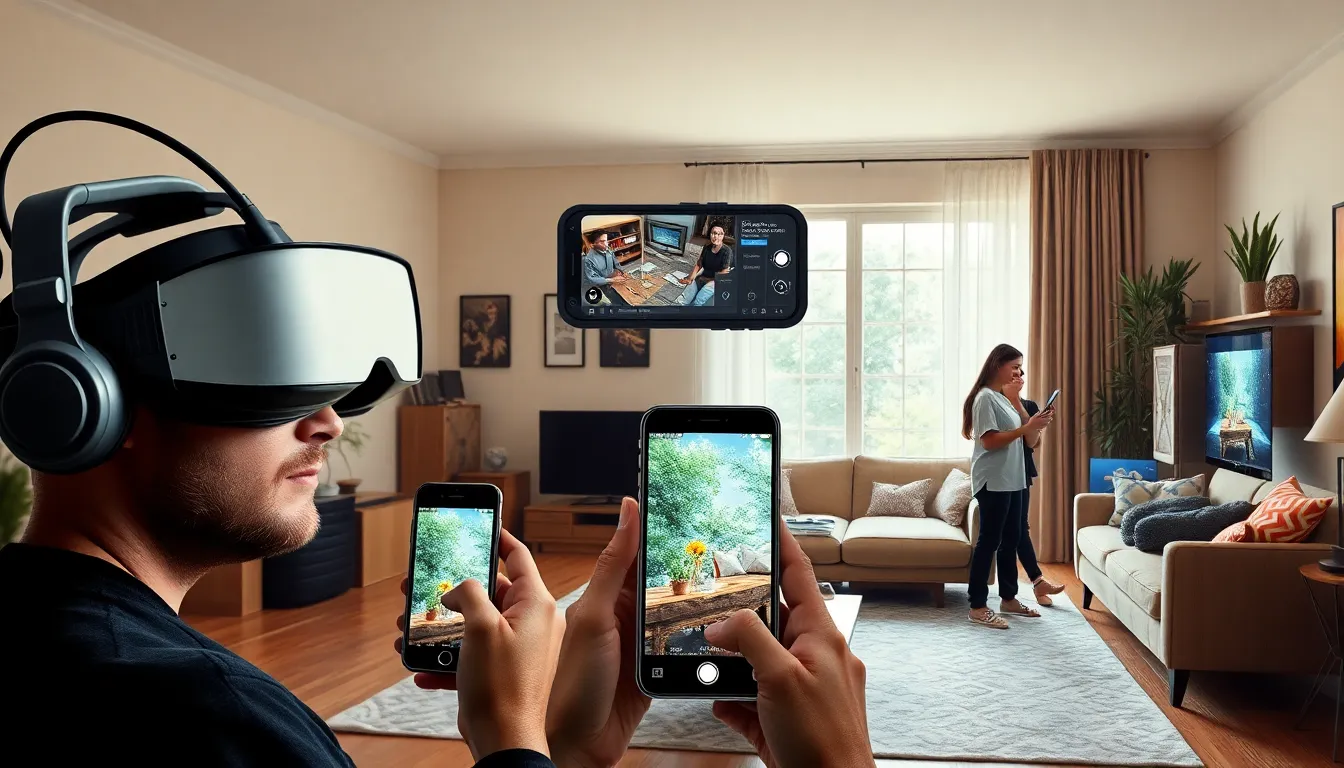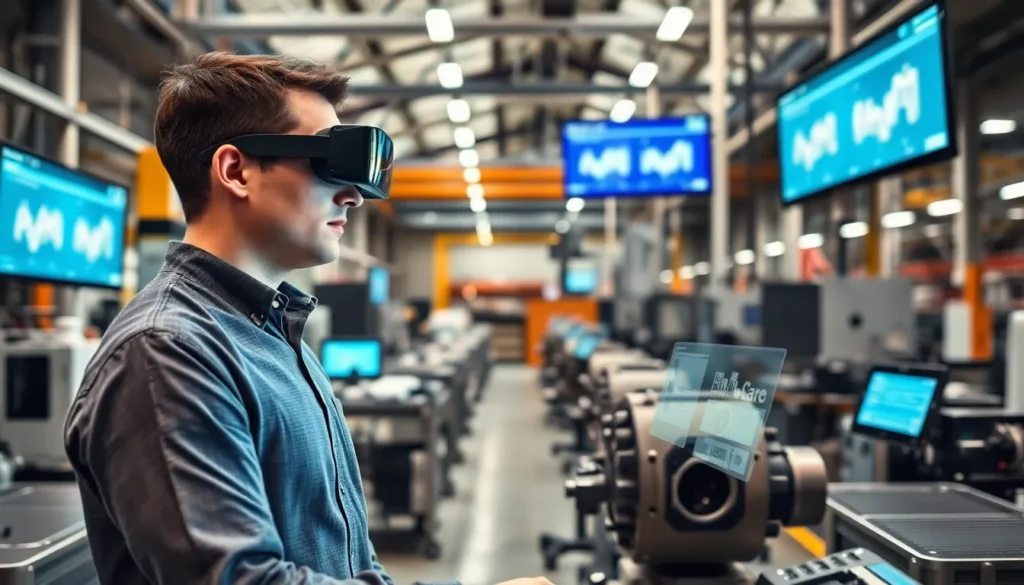Imagine walking down the street and spotting a dinosaur casually munching on a hot dog. Sounds wild, right? Welcome to the world of augmented reality (AR), where the boundary between the digital and physical blurs in the most entertaining ways. AR isn’t just for sci-fi movies; it’s transforming how people interact with their surroundings, turning mundane moments into extraordinary experiences.
Table of Contents
ToggleWhat Is Augmented Reality?
Augmented reality (AR) integrates digital content into the real world. It overlays computer-generated images, sounds, and other data onto a user’s view of their environment, enhancing the way people perceive reality. This technology creates immersive experiences, allowing users to interact with digital elements while engaging with their physical surroundings.
Many devices facilitate AR experiences. Smartphones and tablets serve as the primary tools for AR applications. They use cameras and sensors to recognize the environment and then project relevant digital content onto it. Wearable devices, like smart glasses, also deliver augmented experiences hands-free.
Applications of AR span various industries. In education, students can visualize complex concepts through interactive models. Retailers deploy AR to enable customers to try on clothes virtually or visualize furniture in their homes. Healthcare professionals utilize AR for training simulations and surgical procedures, improving learning and accuracy.
AR’s impact on entertainment is significant as well. Mobile games, such as Pokémon GO, engage millions by blending gameplay with real-world exploration. Museums enhance exhibits through AR guides, providing additional context and information about artifacts.
Statistical data illustrates the growth of augmented reality. The global AR market reached approximately $28.7 billion in 2021 and is expected to grow at a compound annual growth rate of around 43.8% through 2028. This expansion indicates that businesses increasingly recognize AR’s potential to enhance customer experience and engagement.
Overall, augmented reality transforms how individuals interact with the world around them. By bridging the gap between digital and physical realms, AR enriches everyday life, making it more interactive, informative, and enjoyable.
History of Augmented Reality

Augmented reality has evolved significantly since its inception. Early experiments laid the groundwork for today’s technologies.
Early Developments
The concept of augmented reality dates back to the 1960s. Ivan Sutherland created the first head-mounted display system, known as the Sword of Damocles. This rudimentary device overlaid simple computer graphics onto the real world but lacked interactivity. By the 1990s, NASA emerged as a key player, utilizing AR for training purposes, enhancing spatial awareness for astronauts. Pocket-sized AR systems appeared later, notably with the development of the Virtual Fixtures system, allowing users to interact with virtual objects in real space. These foundational innovations set the stage for modern AR applications.
Modern Advancements
Recent advancements in augmented reality have transformed the technology’s capabilities. The launch of smartphones equipped with powerful sensors and cameras revolutionized AR experiences. Today, applications like Snapchat and Instagram utilize AR filters for interactive user engagement. In retail, companies like IKEA offer apps that let customers visualize furniture in their homes before purchasing. The gaming industry embraced AR through titles like Pokémon GO, inviting players to explore their surroundings. The global augmented reality market, valued at approximately $28.7 billion in 2021, is projected to grow at around 43.8% through 2028, reflecting its expanding influence across multiple sectors.
How Augmented Reality Works
Augmented Reality (AR) integrates digital elements into the real world, enhancing user experiences through various technologies.
Key Technologies
Smartphones and tablets serve as primary tools in AR. These devices utilize cameras to capture real-world environments while overlaying digital content. Sensors also play a vital role by detecting motion and spatial information. Head-mounted displays, like smart glasses, provide an immersive experience by seamlessly blending digital objects with surrounding reality. GPS technology supports location-based AR applications, making experiences contextually relevant. Computer vision aids in recognizing physical objects and surfaces, ensuring accurate placement of virtual elements. These technologies combine to create interactive and engaging environments.
Types of Augmented Reality
Marker-based AR relies on recognizable visual cues, such as QR codes, to trigger digital overlays. Users can scan a marker to reveal animations or information. Markerless AR does not require any physical markers; it uses GPS and motion sensors for location tracking. This type allows for dynamic interactions with the environment. Projection-based AR projects digital images directly onto physical surfaces, enabling users to interact with the projected content. Superimposition-based AR enhances real-world objects by replacing or adding digital elements. Each type of AR caters to different applications and user needs, showcasing the versatility of the technology.
Applications of Augmented Reality
Augmented reality (AR) transforms multiple sectors by enhancing user experiences and interactions. Its versatility allows for innovative applications that capture attention and provide value.
In Entertainment
Entertainment utilizes AR to create immersive experiences. Users engage with their favorite characters from movies and games through interactive apps. Notable examples include the AR game Pokémon GO, where players explore real-world environments while capturing virtual creatures. Besides gaming, AR enhances live performances by integrating digital graphics into theatrical events. Through these technologies, audiences enjoy a more captivating and interactive viewing experience.
In Education
Education benefits significantly from AR applications. Students can visualize complex concepts through 3D models overlaid on real-world environments. Interactive lessons foster deeper engagement, making learning more enjoyable. For instance, AR platforms like Google Expeditions allow learners to embark on virtual field trips, exploring ancient ruins or the solar system. These experiences promote active learning and help students retain information effectively.
In Retail
Retail leverages AR to enhance the shopping experience. Customers can visualize products in their homes before making a purchase. For example, IKEA’s app allows users to see how furniture would look in their space, helping them make informed decisions. Additionally, AR can provide virtual try-ons for clothing and accessories, reducing the return rate by ensuring better fit and style choices. This integration of AR not only boosts customer satisfaction but also drives sales.
Challenges and Limitations
Augmented reality faces several challenges that impact its widespread adoption. Technical limitations affect performance and user experience. Device compatibility varies significantly among smartphones, tablets, and wearables. Users encounter difficulties when interacting with AR applications across different platforms.
Privacy concerns also emerge as a significant issue. Collecting and processing real-world data may compromise user privacy. Data breaches could lead to unauthorized access to personal information. Ensuring secure data handling practices is crucial for maintaining user trust.
Cost implications present another hurdle. Developing high-quality AR applications often requires substantial investment in technology and talent. Many startups struggle to secure funding for AR projects due to the perceived risks involved. Limited budgets may hinder innovation or lead to compromises in performance and quality.
Content creation remains a barrier. Producing engaging AR experiences requires specialized skills and resources. Brands may find it challenging to develop unique content that distinguishes their offerings in a crowded marketplace. Without compelling content, user engagement diminishes, reducing the overall impact of AR solutions.
Additionally, user experience can be inconsistent. Technical glitches can disrupt the flow of AR interactions, leading to frustration. Users may also face difficulties in understanding how to navigate various AR applications. Creating intuitive interfaces is essential for maximizing user satisfaction and driving adoption.
Lastly, regulatory challenges can impede AR’s growth. Developing regulations that address safety and privacy in AR environments poses a complex task for policymakers. Adapting to changing legal landscapes is vital for AR companies aiming to operate sustainably and responsibly.
Future of Augmented Reality
Investments in augmented reality (AR) are expected to drive significant advancements. The global AR market reached approximately $28.7 billion in 2021 and is set to grow at a compound annual growth rate of around 43.8% through 2028. Enhanced hardware and software capabilities will enable more seamless integration of digital content into everyday life.
Applications in healthcare show promising developments. Surgeons can utilize AR for improved precision during complex procedures, allowing for real-time overlays of patient information. Educators might adopt immersive AR solutions that engage students more deeply in learning experiences, making abstract concepts tangible.
Retail innovation continues to expand as businesses integrate AR for virtual try-ons and interactive shopping experiences. Customers can visualize products in their own spaces before making a purchase. Increased adoption of AR in e-commerce enhances customer satisfaction, potentially leading to higher conversion rates.
Gaming will likely evolve alongside AR technology. New games may encourage exploration of real-world environments, blending outdoor activities with digital challenges. Developers could create more engaging experiences, making AR a significant player in the gaming industry.
Challenges surrounding privacy and data security must be addressed. As AR relies on real-world data collection, companies face scrutiny related to user consent and data protection. Navigating regulatory frameworks will be essential to ensure that AR can develop responsibly.
User experience remains a priority for developers. Creating intuitive interfaces will help minimize technical glitches and enhance navigation. As AR technology matures, a focus on user-friendly design can lead to broader acceptance and use across various sectors.
Augmented reality is reshaping how people perceive and interact with their surroundings. By merging the digital and physical realms, AR enhances everyday experiences in numerous sectors. From education to entertainment and retail, its applications are vast and varied.
As technology continues to evolve, the potential for AR to create more immersive and interactive experiences grows. However, addressing challenges like privacy concerns and technical limitations will be essential for its widespread adoption. The future of AR holds exciting possibilities, promising to enrich lives and transform industries in ways that are just beginning to be realized.





